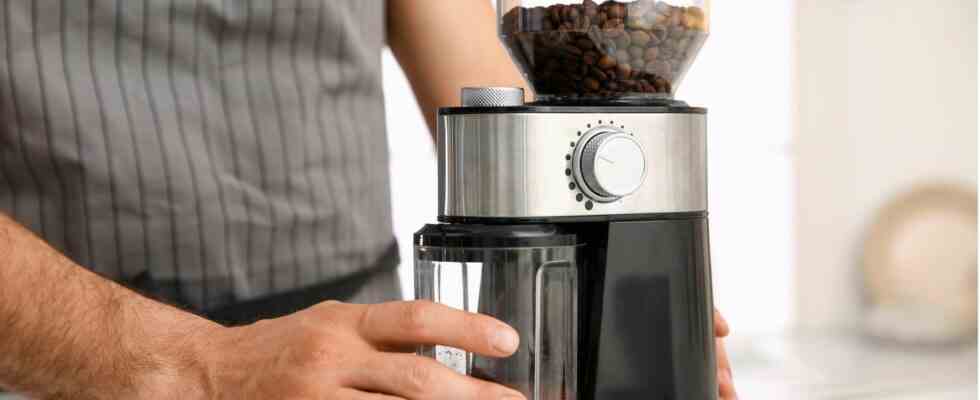More taste
A coffee grinder with a cone, disc or impact grinder: which is better?
A coffee grinder with a conical grinder is a must-have for many coffee lovers
© Liudmila Chernetska / Getty Images
If coffee beans are pre-ground, the aromas they contain react with the air and evaporate. Airtight packaging slows down this process, but doesn’t stop it. If you want to enjoy the full flavor of the whole bean, a coffee grinder is recommended.
The roasting process gives coffee beans an intense aroma that is stored inside. If they are then ground and thus broken up, the ingredients escape and (when brewing) develop their full taste. For this reason, the beans should only be ground when you want to drink a coffee. Pre-ground varieties do not offer this option, but whole beans do. Provided, of course, that you have a suitable mill with a cone, disc or impact grinder. In this article you can find out how the grinders differ.
This is where common grinders differ
An electric coffee grinder is used to finely grind whole beans without heat. This is made possible by its integrated grinder, which is driven by a small motor. Depending on the manufacturer, coffee grinders are now equipped with a conical or disc grinder, in the past even a percussion grinder was installed. But what exactly do the terms actually mean and how do the grinders differ? We’ll tell you:
cone grinder
One works differently than the two following grinders Coffee grinder with cone grinder Particularly gentle: Due to the low speed, the beans are only exposed to low heat so that they retain their full flavor. They are processed into a fine powder by being ground by a rotating cone (also called a conical grinder). Gravity plays an important role in this. The smaller the distance, the finer the result. For this reason, the coffee grinder with a conical grinder is often preferred to the other models.
disc grinder
Two discs, one on top of the other, curved inwards, grind the coffee beans into a fine powder. This is made possible by the fact that the distance between the toothed discs decreases from the inside to the outside. speak, one Coffee grinder with disc grinder (made of ceramic or steel) uses centrifugal force to achieve an even result. You determine how coarse or fine the coffee powder should be by the distance between the discs. The only drop of bitterness here is that the high speed generates heat, which unfortunately can have a negative effect on the aroma.
impact grinder
While it was still common practice in the 20th century to equip coffee grinders with impact grinders, this construction technology is now outdated. And there is a reason for that: Unlike cone and disc grinders, the beans are crushed by a rotating stainless steel blade, like in a blender. This creates so much heat that the coffee gets a bitter taste. In addition, the finished coffee powder is often ground unevenly. The only positive thing is that one Coffee grinder with impact grinder is cheaper to buy than its more expensive successors.
Comparison of coffee grinders with conical grinders
1. Silvercrest coffee grinder
Probably the cheapest model in this series is the coffee grinder with a conical grinder Silvercrest SKKM 200 A1: With a capacity of 250 grams, the 200 watt device grinds whole beans into a fine powder. According to the manufacturer, the result is suitable for all common filter coffee machines and espresso machines or even a French press. The degree of grinding can be set individually, as can the amount of coffee powder.
More details:
- Weight: 1913g
- Size: 190*142*330mm
2. Rommelsbacher coffee grinder
the Coffee grinder EKM 300 from Rommelsbacher with a conical grinder made of stainless steel may be filled with a maximum of 200 grams of coffee beans. The grinder has twelve different levels that you can choose from. Equipped with 150 watts, the device can grind up to ten cups. Thanks to the integrated aroma protection cover, the beans should have as little contact with the air as possible so that they retain their intense taste.
More details:
- Weight: 1700g
- Size: 205*140*290mm
3. Melitta coffee grinder
This 160 watt grinder is also equipped with a conical grinder made of steel Coffee grinder alibra 1027-01 by Melitta. Compared to the other models, it has two big advantages to offer: an integrated scale and a digital gram display. There are also three different grinding programs (number of cups, grams or time) that you can choose from. You can also set the degree of grinding – from coarse to fine – individually.
More details:
- Weight: 2370g
- Size: 374*120*227mm
4. Graef coffee grinder
Stiftung Warentest chose this coffee grinder with a conical grinder CM 800 from Graef already the test winner in 2019. The 120 watt motor can grind a maximum of 350 grams of beans. Thanks to 40 different grinding settings – from fine (for espresso) to medium (for filter coffee) to coarse (for French or Aero Press) – you can adapt the powder to your personal taste. Another plus is the automatic grinding function for portafilters.
More details:
- Weight: 2540g
- Size: 385*132*230mm
Inexpensive alternative: a manual hand mill
In contrast to an electrically operated coffee grinder, the manual hand mill cheaper. For this you have to grind the beans by hand. It has a powerful cone painting mechanism made of ceramic or stainless steel, which – depending on the manufacturer – can even be adjusted individually. On some models, the degree of grinding is infinitely variable, which is intended to guarantee an even result. Another advantage of hand mills is that they are much smaller and therefore take up less space in the kitchen. In addition, the low speed when cranking has a positive effect on the taste.
You might also be interested in:
This article contains so-called affiliate links. Further information are available here.


